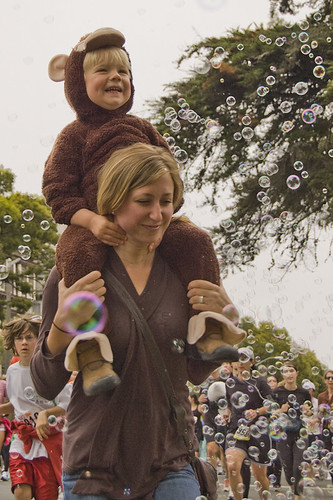
Bay to Breakers will celebrate its 100th anniversary May 15 with new rules, including a ban on drinking and floats on the course.
“Come dressed up in your wackiest costumes, come run, come with nothing at all — but just don’t come drunk this year,” said Stephanie Reichin, a spokeswoman for the event.
The changes have been met with a strong resistance from some participants of Bay to Breakers and residents in the Bay Area, although it is complaints from neighborhood organizations about drunk runners not behaving themselves that led to the rule changes.
Citizens for Preservation of Bay2Breakers is one of the groups dedicated to battle the changes and it currently has more than 15,000 members.
“We want to preserve one of the most important San Francisco cultural institutions of the year,” said Ed Sharpless, the group’s creator. “It’s not in the best interest of anybody to turn this into an ordinary 12K road race. We have enough marathons in this town. We don’t need another one.”
Drawing thousands of runners and even more spectators, Bay to Breakers promises a uniquely San Francisco experience.
“Either you run it or just watching it, it seems enjoyable just being out there for the festivities,” said Susan Ly, a liberal studies major who will run the foot race this year.
In past years, spectators could expect to see pink gorillas, ballerinas, Elvis impersonators and naked grandpas – some on their feet, some on over-the-top floats cruising the race route.
Opponents fear that this festive atmosphere will be lost if the rule changes are enforced.
“(The ban on the floats is) destroying a huge part of the pageantry of the event and really taking away a big part of the spirit of the Bay to Breakers. It’s sad,” said Sharpless, who was on one of the floats last year.
Sharpless said the changes will alter San Francisco values.
“People here are free spirits,” Sharpless said. “By definition it’s different for everyone. And that’s the point. When somebody comes in and tries to mandate or dictate what values San Franciscans should have… it’s not something that goes over very well. People want the freedom to be who they are, act the way they want to act. It’s one of the reasons that made the city so great.”
For the past few years, the race organizers promised to enforce the rule of no alcohol, but the sight of people getting drunk on the course was still a part of the race.
This year, Reichin said the organizer is serious, with a zero tolerance policy in place when it come to alcohol consumption.
People will be taken to “sobering tents,” which will be set up along the course, if they appear to be intoxicated.
The tents are meant to lessen the pressure on the city’s resources, such as ambulances, according to Albie Esparza, spokesmen for the San Francisco Police Department.
Sharpless, however, questioned the ability of police to stop thousands of people from drinking.
“There are 120,000 people out on the streets and as the police always told us every year that there is no way that they would be able to control drinking,” he said.
The more realistic approach to the problem, Sharpless, said is to promote responsible consumption.
“If people can drink responsibly, then, you should be able to drink,” said Ly, a fourth year student at SF State. “But then, it’s illegal to drink outside in the daylight (in public.) So I don’t think this race should be an exception.”




